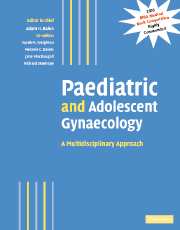Book contents
- Frontmatter
- Contents
- Contributors
- Preface
- Part I Normal development
- Part II Management of developmental abnormalities of the genital tract
- 9 Management of ambiguous genitalia at birth
- 10 Imaging of the female pelvis in the evaluation of developmental anomalies
- 11 Surgical correction of vaginal and other anomalies
- 12 Laparoscopic techniques
- 13 A nonsurgical approach to the treatment of vaginal agenesis
- 14 Psychological care in disorders of sexual differentiation and determination
- 15 The needs of the adolescent patient and her parents in the clinic
- 16 Communicating a diagnosis
- 17 Patients and parents in decision making and management
- Part III Management of specific disorders
- Index
- Plate section
- References
10 - Imaging of the female pelvis in the evaluation of developmental anomalies
from Part II - Management of developmental abnormalities of the genital tract
Published online by Cambridge University Press: 04 May 2010
- Frontmatter
- Contents
- Contributors
- Preface
- Part I Normal development
- Part II Management of developmental abnormalities of the genital tract
- 9 Management of ambiguous genitalia at birth
- 10 Imaging of the female pelvis in the evaluation of developmental anomalies
- 11 Surgical correction of vaginal and other anomalies
- 12 Laparoscopic techniques
- 13 A nonsurgical approach to the treatment of vaginal agenesis
- 14 Psychological care in disorders of sexual differentiation and determination
- 15 The needs of the adolescent patient and her parents in the clinic
- 16 Communicating a diagnosis
- 17 Patients and parents in decision making and management
- Part III Management of specific disorders
- Index
- Plate section
- References
Summary
Introduction
The use of imaging for the evaluation of developmental anomalies of the female pelvis has rapidly expanded since the 1980s mainly because of the development and availability of imaging technology, particularly high-resolution ultrasound with Doppler, spiral computed tomography (CT) and magnetic resonance imaging (MRI). Imaging is now used in virtually every case to confirm diagnosis or to show the anatomy of the structural abnormalities of the genital tract and other related disorders. Imaging is used extensively for planning the surgical management of the primary condition and any associated complications.
The most commonly used imaging modalities are fluoroscopy (usually with contrast agents), ultrasound and MRI. Each technique has particular advantages and disadvantages, and knowledge of these is important for the appropriate choice of imaging technique. A major consideration when imaging children is the use and dose of ionizing radiation, particularly as many patients are likely to need multiple investigations during the course of their lifetime.
Imaging modalities
Fluoroscopy
Genitograms and micturating cystourethrography are the traditional fluoroscopic methods for evaluating children with disorders of sexual differentiation. All perineal orifices are examined with the catheter inserted only a short distance into the orifice. Contrast is injected gently under direct fluoroscopic screening to allow visualization of the morphology of the urogenital sinus. The important features that are noted include the presence or absence of a vagina, its relationship to the urethra and the level of the external sphincter (which has important surgical implications), and the recognition of a male or female type urethral configuration (Aaronson, 1992).
- Type
- Chapter
- Information
- Paediatric and Adolescent GynaecologyA Multidisciplinary Approach, pp. 104 - 119Publisher: Cambridge University PressPrint publication year: 2004



